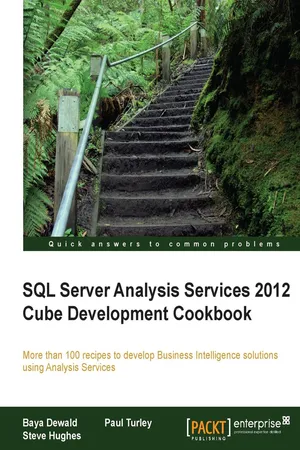![]()
SQL Server Analysis Services 2012 Cube Development Cookbook
![]()
Table of Contents
SQL Server Analysis Services 2012 Cube Development Cookbook
Credits
About the Authors
About the Reviewers
www.PacktPub.com
Support files, eBooks, discount offers and more
Why Subscribe?
Free Access for Packt account holders
Instant Updates on New Packt Books
Preface
What this book covers
What you need for this book
Who this book is for
Conventions
Reader feedback
Customer support
Downloading the example code
Errata
Piracy
Questions
1. Introduction to Multidimensional Data Model Design
Introduction
The business value of Business Intelligence
Challenges and barriers of effective BI
Overcoming BI challenges and barriers
Choosing multidimensional or Tabular Models
Star- or Snowflake-relational schema
A sample scenario for choosing the Snowflake schema
2. Defining Analysis Services Dimensions
Introduction
Defining data sources
How to do it...
How it works...
There's more...
Defining data source views
Getting started
How to do it...
Defining entity relationships in DSV
How to do it...
Extending data source views
How to do it...
Creating named calculations and queries
How to do it...
Creating simple dimensions
Getting ready
How to do it...
How it works...
Building dimension hierarchies
How to do it...
There's more
Setting dimension properties
Setting essential attribute properties
How to do it...
Browsing dimension data
Getting ready
How to do it...
How it works...
Sorting the attributes
How to do it...
Customizing advanced attribute properties
How to do it...
How it works...
Creating parent-child dimensions
How to do it...
How it works...
There's more...
Creating the date and time dimensions
How to do it...
There's more...
3. Creating Analysis Services Cubes
Introduction
Defining measure groups and measures
Getting ready
How to do it...
Setting measure properties
How to do it...
There's more...
Browsing the cube data
How to do it...
Dimension usage with measure group
How to do it...
Examining cube file structures
How to do it...
There's more...
Partitioning strategies
How to do it...
Creating partitions through the wizard
Creating partitions through AMO
Partition storage mode options
Defining partition slice
How to do it...
Merging partitions
How to do it...
Defining aggregation designs
Using BIDS Helper for customizing aggregations
How to do it...
There's more...
Distinct count measure groups
How to do it...
There's more...
Enabling write-back feature
How to do it...
Deployment options
How to do it...
4. Extending and Customizing Cubes
Introduction
Defining calculated measures
Getting ready
How to do it...
Defining named sets
How to do it...
Defining drillthrough actions
How to do it...
How it works...
Defining URL actions
How to do it...
Defining reporting actions
How to do it...
Defining key performance indicators
How to do it...
Defining perspectives
How to do it...
Defining translations
How to do it...
Defining measure expressions
How to do it...
5. Optimizing Dimension and Cube Processing
Introduction
Understanding dimension processing options
How it works...
Learning about basic dimension processing
Getting ready
How to do it...
How it works...
Learning advanced dimension processing options
How to do it...
Using out-of-line bindings for dimension processing
How to do it...
Dealing with partition processing options
How to do it...
How it works...
Using SQL Server Integration Services to process Analysis Services objects
How to do it...
Monitoring and tuning processing performance
How to do it...
6. MDX
Introduction
Returning data on the query axes
Getting ready
How to do it...
Limiting the query output
How to do it...
Sorting the query output
How to do it...
Defining query level calculations and named sets
How to do it...
Navigating dimension hierarchies
How to do it...
Working with the Time dimensions
How to do it...
MDX script's functionality
How to do it...
Monitoring and tuning MDX queries
How to do it...
There's more...
7. Analysis Services Security
Introduction
Managing instance-level administrative security
How to do it...
Managing database-level security
How to do it...
Managing cube-level security
How to do it...
Managing dimension hierarchy-level security
How to do it...
How it works...
Implementing dynamic dimension security
How to do it...
There's more...
Implementing cell-level security
How to do it...
There's more...
8. Administering and Monitoring Analysis Services
Introduction
SSAS instance configuration options
How to do it...
How it works...
There's more...
Creating and dropping databases
Getting ready
How to do it...
Monitoring SSAS instance using Activity Viewer
How to do it...
How it works...
Monitoring SSAS instance using DMVs
How to do it...
How it works...
There's more...
Cancelling a session
How to do it...
Checking whether cubes are accessible
How to do it...
Checking SSAS object sizes programmatically
How to do it...
There's more...
Scaling out SSAS solutions
Backup and restore
How to do it...
How it works...
Synchronizing databases
How to do it...
How it works...
Detaching and attaching databases
How to do it...
How it works...
9. Using Tabular Models
Introduction
Creating a Tabular Model
Getting ready
How to do it…
There's more…
Working with data sources and loading data
How to do it…
There's more…
Modeling the data
Getting ready
How to do it…
How it works…
There's more…
See also
Creating a hierarchy
How to do it…
There's more…
Creating a calculated measure
Getting ready
How to do it…
See also
Creating a calculated column
How to do it…
There's more…
See also
Creating a KPI
Getting ready
How to do it…
There's more…
See also
Analyzing your model in Excel
How to do it…
There's more…
See also
Deploying Tabular Models
Getting ready
How to do it…
How it works…
There's more…
See also
Scripting Tabu...
